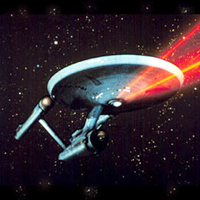
U.S.S. Enterprise (NCC-1701)
CBUB Wins: 1
CBUB Losses: 5
CBUB Ties: 0
Win Percentage: 16.67%
Added by: wishtiger
The USS Enterprise, NCC-1701, is a fictional starship in the Star Trek media franchise. The original Star Trek series depicts her crew's mission "to explore strange new worlds; to seek out new life and new civilizations; to boldly go where no man has gone before" under the command of Captain James T. Kirk. The ship's basic design "formed the basis for one of sci-fi's most iconic images". A refit version of the ship appears in the first three Star Trek films. The 2009 Star Trek film, which takes place in an "alternate, parallel" timeline, includes a redesigned version of the Enterprise.
Star Trek art Director Matt Jefferies designed the original Enterprise, which in series creator Gene Roddenberry's first series outline drafts was named Yorktown. The ship's "NCC-1701" registry number stemmed from "NC" being one of the international aircraft registration codes assigned to aircraft registered in the United States; the second "C" was added for differentiation. The "1701" was chosen in order to avoid any possible ambiguity (according to Jefferies himself, the numbers 3, 6, 8 and 9 are "too easily confused" ). Other sources cite it as a reference to the house across the street from where Roddenberry grew up.
The first miniature built for the pilot episode "The Cage" (1965) was unlit and approximately 3 feet (91.4 cm) long. It was modified during the course of the series to match the changes eventually made to the larger miniature, and appears on-set in "Requiem for Methuselah" (1969). The second miniature built for the first pilot measures 11 feet 2 inches (3.4 m) long and was built by a small crew of model makers, Volmer Jensen, Mel Keys, and Vernon Sion, and supervised by Richard Datin, working out of Jensen's model shop in Burbank, California, and initially filmed by both Howard A. Anderson and Linwood G. Dunn at Dunn's Film Effects of Hollywood facility, who also re-filmed later more-elaborate models of the ship, generating a variety of stock footage that could be used in later episodes.
Initially, the model was static and had no electronics. For the second pilot, "Where No Man Has Gone Before" (1966), various details were altered, and the starboard window ports and running lights were internally illuminated. When the series was picked up and went into production, the model was altered yet again. These alterations included the addition of translucent domes and blinking lights at the forward ends of the engine nacelles, smaller domes at the stern end of the engine nacelles, a shorter bridge dome, and a smaller deflector/sensor dish. Save for re-used footage from the two pilot episodes, this was the appearance of the ship throughout the series. The 11-foot model stands in the Gift Shop downstairs at the Smithsonian Institution's National Air and Space Museum in Washington, D.C.
CBUB Match Record:
| Result | Opponent | My Score | Their Score | |
|---|---|---|---|---|
| Loss | Ego the Living Planet | 36 | to | 52 |
| Loss | Super Star Destroyer | 39 | to | 78 |
| Loss | Super Star Destroyer | 31 | to | 74 |
| Loss | The Xenomorphs | 11 | to | 19 |
| Loss | The Xenomorphs | 7 | to | 10 |
| Win | The Huxtables | 2 | to | 1 |
No Fantasy Draft Records Available
